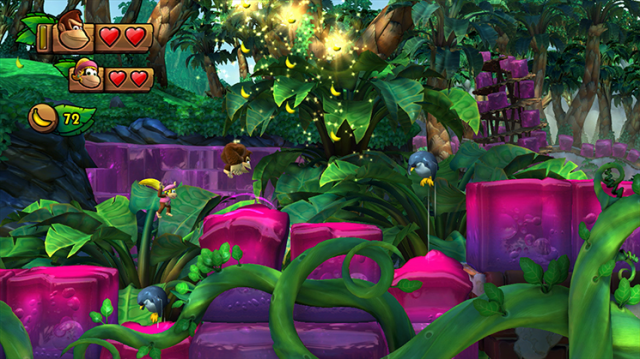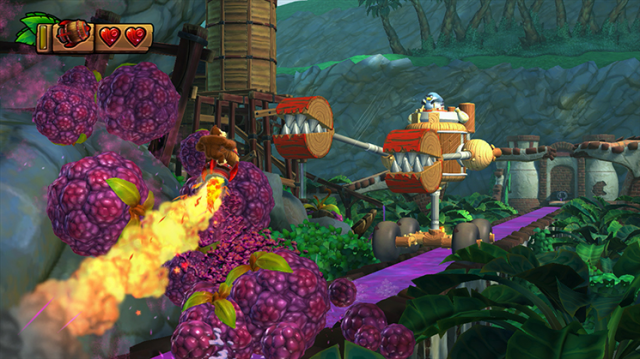
Balancing out this trend has been a rash of games that revel in being as difficult and obtuse as possible. Games like Demon’s Souls, Super Meat Boy, Spelunky, DayZ and a host of others aren’t shy about throwing the player in with minimal instruction and letting them earn their skill by dying again and again and again.
Much like 2011’s Wii reboot of Donkey Kong Country Returns (more so than the SNES Donkey Kong Country that came before it), the new Donkey Kong Country: Tropical Freeze charts a careful, retro-inspired course between these extremes. It’s a very difficult game—punishingly difficult, at times—but it's also friendly and approachable enough to avoid scaring off players who wouldn’t spend more than five minutes playing Super Meat Boy. It’s an old-school approach to difficulty that isn’t quite “Nintendo hard” in the traditional sense, but presents a good, modern moderation of that idea.
The difficulty in Tropical Freeze ramps up so gradually that you barely notice it. Yet somewhere between the first two worlds and the last two, the game goes from an easy, friction-free skate to a punishing, split-second timing slog. It’s these last few worlds that stick in my mind as I write this, full as they are with quick-moving platforms, frustrating enemy placements, shots out of barrels that require precise timing, and punishing auto-scrolling sections that leave little room for error. I found the last few bosses especially frustrating, each turning into a war of attrition as I struggled to stay alive long enough to fit in nine separate attacks during all-too-brief defensive openings.
At the same time, the game throws in plenty of helpful bonuses, like an attentive mother picking you up and telling you she's sure you’ll succeed this time. Life-granting bananas and extra-life balloons are so prevalent that I finished the game near the maximum of 99 lives, despite easily dying 100 times in the last couple of hours of gameplay. The decently long levels are broken into relatively frequent checkpoints, to save you the frustration of having to complete long sections over and over. You can buy items like extra hit points and balloons that save you from falling in a pit, which helped immensely in struggling through those last few levels.
Visually, the game is approachable in a way that starkly contrasts with its difficulty. Levels are full of bright colors, and even the fiercest enemies are rendered in Nintendo’s standard Saturday-morning cartoon style. The game is constantly throwing around new visual tropes; a series of levels set in a fruit processing plant were particularly memorable, as are the auto-scrolling vehicle sections that change the perspective to a three-quarters 3D view at oncoming obstacles.
In another nice old school design trick, the game lets you manage difficulty on your own by offering a lot of optional items. Simply getting through a level usually isn't nearly as tough as getting through while collecting the hidden puzzle pieces, K-O-N-G letters, banana coins, and other assorted secrets. These optional items are often placed in out-of-the-way or in particularly hard-to-reach parts of the level, providing a great risk/reward system that players can self-calibrate on the fly.

Unfortunately, some of the difficulty in Tropical Freeze comes from the movement system. Donkey Kong takes a brief moment to get up to full speed in his normal walk cycle (from a standing start), but it’s not immediately apparent from the animation that he’s not quite going at full tilt. The result is a lot of jumps where you don’t quite have the forward momentum you expected to, unless you’ve gotten a good running start beforehand.
The best practical solution I found for this “standing start” problem was to go into a roll, which throws Donkey Kong forward quickly, and then jumping immediately, guaranteeing my forward speed. This was more than a little awkward, though, and it was difficult to control with precision. On the plus side, the roll-off-a-ledge-then-jump-magically-in-mid-air trick from the original Donkey Kong Country series (and Returns) is still useful for extending your jumps.
The game becomes much more forgiving when you find a barrel with a partner Kong to ride on Donkey Kong’s back. Diddy Kong makes his return from Donkey Kong Returns, offering a brief mid-air hover with a jetpack. It's the addition of Dixie Kong, though, that makes the game feel completely different, giving players a single Yoshi's Island-style flutter and height increase with each jump.
Having Dixie along makes the game much more playable, giving more vertical and horizontal range to key jumps and, crucially, letting players adjust themselves easily in mid-air before tough landings. The ability is so unbalancing that, in certain situation where I lost Dixie to a few errant hits, I would simply restart the level to get her back rather than soldier on solo. Her hover ability felt so integral to the way I played the game that I wished it was a default part of Donkey Kong’s arsenal at all times.
Meanwhile, Cranky Kong’s introduction as a semi-playable character gives you a Ducktales-style pogo cane to get extra height and protection from ground-based hazards. This can be useful, but its utility is a bit too situational, and the bouncing is usually not as desirable as the ability to change directions (and get more hang time in mid-air).
As someone who’s been getting better at platform games for nearly two and a half decades now, I tend to prefer the games in the genre that crank the difficulty bar up to 11 out of 10. Tropical Freeze doesn't quite go that far, but it does a good job of offering a challenge that won’t scare off players that haven’t touched a platform game since the first Donkey Kong Country came out two decades ago.
The good
- Excellent mix of old-school difficulty and accessible design.
- Good variety of gameplay styles and level designs.
- Plenty of secrets and tough-to-get collectibles to keep you coming back.
- Endlessly inventive visual design is constantly changing.
The bad
- Wonky character acceleration can lead to control difficulties.
- Boss fights can go on for frustratingly long.
- Cranky Kong's addition doesn't add much to the game.
The ugly
- Trying to make tough jumps without Dixie Kong's supremely useful floating ability.
Verdict: Buy it if you're in the mood for a platformer like the Wii U's great-grandfather used to make.
reader comments
43